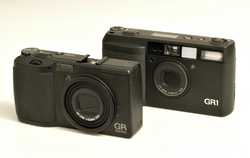Inside Story
Analyzing the charms and allure of the GR1
Ricoh has always been well known as a film camera maker that has a wealth of knowledge in lens technology, typified by the superb GR lens. Furthermore, since the DC1, Ricoh has been accumulating a wealth of technological know-how on digital cameras. “The plan to develop the GR DIGITAL camera was kicked off by the idea that, if we focus all of this technical skill and know-how, we should be able to deliver the very same compact digital camera with high image quality that our customers are demanding”, said Mr. Noguchi.
The initial stages of the development plan were to clearly define exactly why users of the GR1 camera hold the opinion that, “the GR1 is a fantastic camera”. “Regular users of the GR1 are not just amateurs, a lot of professional photographers use it too. We decided that the best place to start would be to thoroughly explore the reasons why those users like the camera so much, then to clearly define a target that each member of the development team could share”, explained Mr. Noguchi. Research was performed on pretty much anyone who had something to say on photographs or cameras, including owners of the GR1, subscribers to camera magazines, high-end amateur photographers, photo cameramen, and journalists.
Towards an “impressive, reliable” camera

Picture of the GR1 and GR DIGITAL cameras.
The GR DIGITAL is slightly smaller.
Requests from the high-end users were the most difficult, and so we took requests such as “high image quality” as a given. Other requests included “able to print A3 size and larger in full color”, “able to make quarter-size and larger film prints”, which are basically requests to be able to make photo magazine center page spread gravure pictures, or prints to exhibit in photograph exhibitions. Detailed requests included “to be able to distinguish individual human hairs”, “clear periphery with no distortion”, “when taking pictures of tree leaves with the sky as a background, to have no colored fringes around the leaves” etc.
“All of the people that gave opinions had detailed knowledge of cameras and photography”, remarked Mr. Noguchi. “Every possible point was covered, for example “a decreased amount of ambient light on release is permissible, but ambient light must not decrease on close”, and extensive opinions on noise, tone, grayscale, chromatic aberration etc were received. It seemed like everything that we had been considering to that point had been substantiated, and our team thought, “I thought so too”, and “I see” when we read the opinions”.
It was found that “compact size” was also a standard request. However, many users wanted operability not yet developed for digital SLR cameras, such as instant operation when you think “Now!” and press the shutter release. Furthermore, many users seemed to view such operational aspects as “easy to see finder”, “easy to shoot”, “easy to set up”, “comfortable to hold” etc. as highly important. Mr. Noguchi also said “some opinions requested “I want to get a kick out of pressing the shutter release button” or “the kind of camera I would keep on my bedside table””. The concept was beginning to come clear, the GR DIGITAL should make an impression on the user when they hold it, and it should be reliable. The concept can be expressed more concretely in the 5 points below.
|
These were all included in the specs.


